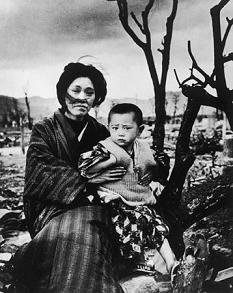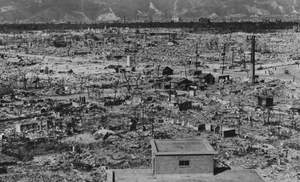How American
journalists covered
the first use of
the atomic bomb
Seventy years ago this week, the US military revealed the greatest (and best-kept) secret of the Allied effort to win World War II. The use of the atomic bomb proved to the world that it was indeed possible to make one. But how had it been possible to keep the secret? And how did US journalists break the news?
From New York to Oak Ridge
In April of 1945, General Leslie Groves of the US Army approached the managing editor of The New York Times. Based on the research for my history of journalism, Covering America, my belief is that this was a critical step in finally informing the public. The general wanted to borrow the Times’ science writer, William Laurence, for the remainder of the war.
Without many more preliminaries, Laurence headed off to his new assignment in Oak Ridge, Tennessee. There, Groves pulled back the shroud protecting the nation’s biggest wartime gamble and introduced Laurence to the Manhattan Project.
The Army wanted a civilian on board who could help with drafting press releases, writing news stories, and explaining the vast and complex undertaking to the general public.
Laurence was a good choice. A native of Lithuania, Laurence had immigrated to the United States as a teenager and attended Harvard and Boston University. At the Times, he had pioneered covering science for a general newspaper and had won a Pulitzer Prize in 1936.
Once attached to the Manhattan Project, Laurence had virtual carte blanche to travel to the various bomb-making sites around the country, interviewing the top scientists and engineers, and he soon knew more about the project than all but a handful of the thousands of people working on it.
In July, Laurence went to a site near Alamagordo in the New Mexico desert to witness the first test explosion of an a-bomb, code-named Trinity.”
It was Laurence who wrote the (false) press release that the Army used to concoct a cover story. The few civilians in the surrounding areas who saw the great flash on July 15 were assured that there was nothing to worry about, just an old ammo dump that had blown up. In fact, the Army was exposing everyone in the surrounding states to their first dose of airborne radiation.
A New York Times exclusive
In gratitude for Laurence’s services, the Army tipped the top management of the Times on August 2 about the impending use of the bomb against Japan, so the paper could prepare.
On August 6, 1945, the world first learned about the atomic bomb when the United States dropped it on the Japanese city of Hiroshima. Three days later, the Army Air Corps struck again, this time at Nagasaki. On board one of the aircraft on August 9 was Laurence.
As the official journalistic witness to the Manhattan Project, he was now the first American civilian to observe the use of the terrible new weapon in war. His detailed, poetic narrative (which appeared in the Times a month later) began simply: “We are on our way to bomb the mainland of Japan.”
As the hours ticked by en route to the target, Laurence mused in print about the morality of setting out to wipe an entire city off the map.
He asked himself if he felt any pity for the “poor devils” who would be obliterated by the bomb. His answer: “Not when one thinks of Pearl Harbor and of the Death March on Bataan.” In other words, he figured (as did many Americans) that the “Japs” had it coming.
Then, over Nagasaki, Laurence and the crew beheld the existential chaos unleashed by splitting the atom:
Awe-struck, we watched it shoot upward like a meteor coming from the earth instead of from outer space, becoming ever more alive as it climbed skyward through the white clouds. It was no longer smoke, or dust, or even a cloud of fire. It was a living thing, a new species of being, born right before our incredulous eyes.
At one stage of its evolution, covering millions of years in terms of seconds, the entity assumed the form of a giant square totem pole, with its base about three miles long, tapering off to about a mile at the top. Its bottom was brown, its center was amber, its top white. But it was a living totem pole, carved with many grotesque masks grimacing at the earth…
It kept struggling in an elemental fury, like a creature in the act of breaking the bonds that held it down. In a few seconds it had freed itself from its gigantic stem and floated upward with tremendous speed, its momentum carrying into the stratosphere to a height of about 60,000 feet…
As the mushroom floated off into the blue it changed its shape into a flowerlike form, its giant petal curving downward, creamy white outside, rose-colored inside. It still retained that shape when we last gazed at it from a distance of about 200 miles.
Laurence’s critics
Laurence struck a note of awe at the dawn of the atomic age. In the coming weeks, he elaborated on the theme in a series of Pulitzer Prize-winning articles in the Times, explaining for a lay audience the basic principles of atomic energy.
In recent years, Laurence has been criticized by some journalists who believe that he was compromised as a reporter because of his attachment to the military.
He was also faulted for downplaying the effects of radiation, and some have called for the Times to return the 1946 Pulitzer Prize awarded to Laurence.
In addition, it should be noted that, for all the poetic power of his Nagasaki piece, there were limits to Laurence’s perspective; he was seeing the experience from the point of view of the attackers.
Through no fault of his own, he was peering outward and downward at an object, not observing the individual human agonies unfolding on the ground.
There were, of course, no Allied journalists on the ground in Japan at the time of the bombing, although an advance unit streamed into the country as soon as peace was declared and the occupation began.
Reporting from the ground
Among the first in was Homer Bigart of the New York Herald Tribune, who went with a group of journalists to Hiroshima in early September 1945.
His reporting attempted to reckon the loss of lives – which he put, fairly accurately, at 53,000 dead and 30,000 missing and presumed dead – and then went on to describe the ruins. Starting about three miles from the center of the blast, Bigart reported seeing signs of destruction, typical of what he had seen in bombed cities in Europe:
But across the river there was only flat, appalling desolation, the starkness accentuated by bare, blackened tree trunks and the occasional shell of a reinforced concrete building.
He reported that residents were still dying, at the rate of about 100 a day, mostly from burns and infection, and he hinted at some of the problems eventually recognized as radiation sickness.

Hiroshima, 1945. The United States is the only nation who ever has used nuclear weapons against another people in anger.
The following year, the reporter and author John Hersey visited Hiroshima for the New Yorker magazine. He stayed longer than Bigart had been allowed to, and he created one of the masterpieces of war correspondence.
Through meticulous reporting, Hersey followed the experiences of six individuals who had been in Hiroshima on the morning the bomb exploded. Moment by moment, scene by scene, he recreated the thoughts and actions of each of those survivors, from the minutes before the blast through the first few days and weeks that followed. His reporting was finished in August 1946.
When his editor at the New Yorker, Harold Ross, got a look at the material, he decided to dispense with all the rest of the contents scheduled to run and devoted the August 31 issue to Hersey’s account.
In the mythology surrounding this piece, it is often said that Ross cleared the entire magazine for Hersey’s story. In fact, Ross decided to rip out all the editorial matter, but not the ads or entertainment listings.
Thus, Hersey’s somber masterpiece appears disconcertingly alongside ads for “perma-lift” bras and the “latest hilarity” from S J Perelman, as well as full-page spreads offering civilian versions of such familiar items as the Willys Jeep.
Hersey’s story is a key document of 20th-century history as well as a touchstone for the human imagination in the nuclear age.
His hyperfactual tale of immense suffering has become part of the worldview of most people on the planet. He said almost nothing in his own voice – no pontificating, no summarizing.
Instead, he brought particular people to life by setting them in action and thereby showing the reader what had happened.
The account of the bombing was quickly published as a book, titled simply Hiroshima, which became a bestseller and has remained in print ever since.
Many consider it the greatest work of journalism by an American.
Christopher B Daly, The Conversation – Christopher B Daly is Professor of Journalism at Boston University.
Related articles:
Ban the bomb: 70 years on, the nuclear threat looms
as large as ever
America’s Barbaric Logic of Hiroshima 70 Years On
Hiroshima, Nagasaki and Days that will live in Infamy
Ulrike Meinhof on the War Crimes committed in Dresden
– As Relevant as Ever.
Russia invites NATO Members to Security Conference:
Experts warn about Risk of unwanted Nuclear War
400 % Spike in Rare Birth Defects Near Leaking Hanford
Nuclear Site
++++++++++++
nsnbc – nsnbc international is a daily, international online newspaper, established on 25 February 2013. nsnbc international is independent from corporate, state or foundation funding and independent with regards to political parties. nsnbc international is free to read and free to subscribe to, because the need for daily news, analysis and opinion, and the need for independent media is universal. The decision to make nsnbc international freely available was made so all, also those in countries with the lowest incomes, and those inflicted by poverty can access our daily newspaper. To keep it this way however, we depend on your donation if you are in a position to donate a modest amount whenever you can or on a regular basis. Besides articles from nsnbc’s regular contributors and staff writers, including it’s editor and founder, Christof Lehmann, it features selected articles from other contributors through its cooperation with media partners such as Global Research, The 4th Media, Aydinlik Daily, AltThaiNews Network, New Eastern Outlook, The Cairo Post and others.
>via: http://nsnbc.me/2015/08/08/how-american-journalists-covered-the-first-use-of-the-atomic-bomb/



